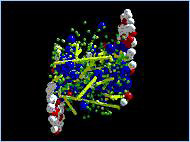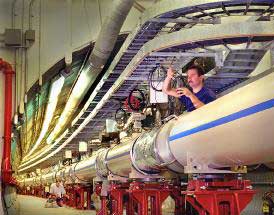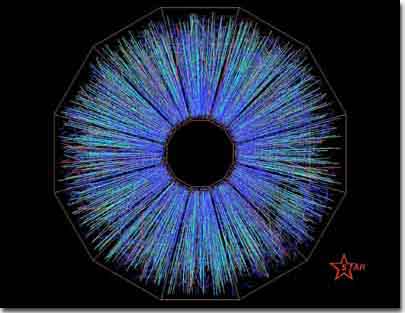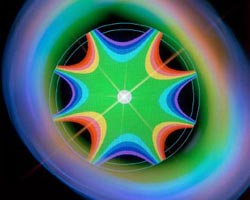Nuclei Knockdown
About RHIC
It's gold! It's smashing!
At RHIC--the Relativistic Heavy Ion Collider, located at the Brookhaven National Laboratory in New York--gold nuclei traveling at nearly the speed of light smash into each other, destroying themselves and producing a spray of other particles. The nuclei speed in opposite directions around a circular "racetrack" with a diameter of about two and a half miles and collide head-on. At these tremendous speeds, a direct hit produces so much energy that the protons and neutrons making up the nuclei may themselves disassociate, forming a soup of sub-nuclear particles termed the "quark-gluon plasma." This plasma is so hot that its temperature is about ten thousand times hotter than the center of the sun.

Computer simulation of a collision between two gold nuclei (image courtesy of Brookhaven National Laboratory)

Curving tube of the RHIC. Most of the volume of the tube is occupied with magnets and liquid helium refrigeration. (photo courtesy of Brookhaven National Laboratory)
Quarks are the particles that make up protons and neutrons. Quarks are so tightly bound to each other that they cannot be observed as separate particles. Physicists can, however, infer the existence of quarks from the characteristics of other particles produced in nuclear collisions at high energy. The force between quarks is provided by particles called gluons.
Why Gold?
A gold atom has a massive nucleus. It has an atomic weight of about 108, which means that the average gold nucleus has a total of 108 protons and neutrons. Smashing such massive nuclei into each other produces collisions with high energies, perhaps enough to create a plasma of quarks and gluons.
Yin and Yang
The universe is about 12 billion light years across. An atomic nucleus is about one 10000000000000th of a centimeter across. Despite this incredible difference in size, the physics of the universe is closely related to the physics of the nucleus. Shortly after the Big Bang , the universe was an extremely hot soup of protons and neutrons. Before that, at even higher temperatures, not even the nuclei could exist, and the universe consisted of quarks, gluons, and radiation. Physicists hope to create this state of matter in the RHIC collider.
Research
Along RHIC's 2.4-mile ring there are four separate experimental detectors housed where the two particle beams intersect. One of these detectors-the Solenoidal Tracker at RHIC, or STAR-is specially designed to track the particles created in each ion collision. This powerful tracking system simultaneously measures various properties of these particles allowing researchers to reconstruct the ion collisions and look for signs of the quark-gluon plasma, or QGP. (The QGP is too short-lived to be detected directly). From these data, scientists hope to gain a fundamental understanding of the microscopic structure of quark-gluon interactions.
The picture at the right is of one of the first full-energy collisions between gold ions as captured by the STAR detector. The tracks provide researchers with almost a 3-D "snapshot" of thousands of subatomic particles produced in the collisions.

This view shows the tracks left by approximately 1000 charged particles after a head-on collision between two gold nuclei in the STAR detector. (photo courtesy of Brookhaven National Laboratory)
Links
Brookhaven National Laboratory
Lawrence Berkeley National Laboratory

Computer simulation of the magnetic fields generated by the superconducting magnets in the RHIC ring. (See Applications of Superconductivity.) These magnetic fields accelerate the nuclei to speed them up and to steer them in a circle. (photo courtesy of Brookhaven National Laboratory)
Daily University Science News
Earth and Sky














